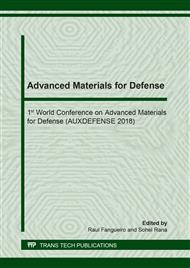[1]
M. White, iCasulaties.org,, 2003. [Online]. Available: http://icasualties.org. [Accessed: 22-Aug-2017].
Google Scholar
[2]
E. Roger, Mines buried in dry and saturated soils : blast experiments, soil modeling and simulations," Ph.D Thesis de l,Université de Grenoble, (2015).
Google Scholar
[3]
D. Bergeron, R. Walker, and C. Coffey, Detonation of 100-gram anti-personnel mine surrogate charges in sand - A test case for computer code validation,, (1998).
Google Scholar
[4]
S. D. Clarke et al., Geotechnical causes for variations in output measured from shallow buried charges,, Int. J. Impact Eng., vol. 86, p.274–283, (2015).
DOI: 10.1016/j.ijimpeng.2015.08.009
Google Scholar
[5]
Nato, AEP-55 Ed. C, Version 1: Procedures for Evaluating the Protection Level of Armoured Vehicles - Vol. 2: Mine Threat,, (2014).
Google Scholar
[6]
O. E. Petel, F. X. Jetté, S. Goroshin, D. L. Frost, and S. Ouellet, Blast wave attenuation through a composite of varying layer distribution,, Shock Waves, vol. 21, no. 3, p.215–224, (2011).
DOI: 10.1007/s00193-010-0295-6
Google Scholar
[7]
G. S. Langdon, S. L. Lemanski, G. N. Nurick, M. C. Simmons, W. J. Cantwell, and G. K. Schleyer, Behaviour of fibre-metal laminates subjected to localised blast loading : Part I - Experimental observations,, Int. J. Impact Eng., vol. 34, no. 7, p.1202–1222, (2007).
DOI: 10.1016/j.ijimpeng.2006.05.008
Google Scholar
[8]
G. S. Langdon, W. J. Cantwell, and G. N. Nurick, The blast performance of novel fibre-metal laminates,, in Structures Under Shock and Impact VIII, 2004, vol. 15, p.455–464.
Google Scholar
[9]
G. S. Langdon, Y. Chi, G. N. Nurick, and P. Haupt, Response of GLARE panels to blast loading,, Eng. Struct., vol. 31, no. 12, p.3116–3120, (2009).
DOI: 10.1016/j.engstruct.2009.07.010
Google Scholar
[10]
G. S. Langdon, W. J. Cantwell, and G. N. Nurick, The blast response of novel thermoplastic-based fibre-metal laminates - Some preliminary results and observations,, Compos. Sci. Technol., vol. 65, no. 6, p.861–872, (2005).
DOI: 10.1016/j.compscitech.2004.09.025
Google Scholar
[11]
D. Karagiozova, G. S. Langdon, and G. N. Nurick, Modelling the Behaviour of Fibre-Metal Laminates subjected to Localised Blast Loading,, IUTAM Symp. Theor. Model. Comput. Asp. Inelast. Media, p.319–328, (2008).
DOI: 10.1007/978-1-4020-9090-5_29
Google Scholar
[12]
D. Karagiozova, G. S. Langdon, G. N. Nurick, and S. Chung Kim Yuen, Simulation of the response of fibre-metal laminates to localised blast loading,, Int. J. Impact Eng., vol. 37, no. 6, p.766–782, (2010).
DOI: 10.1016/j.ijimpeng.2009.04.001
Google Scholar
[13]
S. L. Lemanski, G. N. Nurick, G. S. Langdon, M. C. Simmons, W. J. Cantwell, and G. K. Schleyer, Understanding the behaviour of fibre metal laminates subjected to localised blast loading,, Compos. Struct., vol. 76, p.82–87, (2006).
DOI: 10.1016/j.compstruct.2006.06.012
Google Scholar
[14]
S. L. Lemanski, G. N. Nurick, G. S. Langdon, M. C. Simmons, W. J. Cantwell, and G. K. Schleyer, Behaviour of fibre metal laminates subjected to localised blast loading - Part II : Quantitative analysis,, Int. J. Impact Eng., vol. 34, no. 7, p.1223–1245, (2007).
DOI: 10.1016/j.ijimpeng.2006.05.009
Google Scholar
[15]
G. S. Langdon, G. N. Nurick, and W. J. Cantwell, The response of fibre metal laminate panels subjected to uniformly distributed blast loading,, Eur. J. Mech. A/Solids, vol. 27, no. 2, p.107–115, (2008).
DOI: 10.1016/j.euromechsol.2007.09.003
Google Scholar
[16]
V. F. Nesterenko, Transformation of Shocks in Laminated and Porous Materials,, in Dynamics of Heterogeneous Materials, L. Davison and Y. Horie, Eds. Springer-Verlag New York, 2001, p.246–306.
DOI: 10.1007/978-1-4757-3524-6_3
Google Scholar
[17]
B. Fei, High-performance fibers for textiles,, in Engineering of High-Performance Textiles, Elsevier., M. Miao and J. Xin, Eds. Woodhead Publishing, 2017, p.544.
Google Scholar


